5 Horrifying Ways Old Hollywood Was A Living Hell
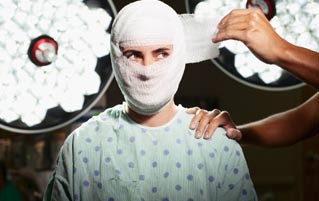
Trying to get ordinary people to feel sorry for rich, entitled celebrities is like getting rich, entitled celebrities to remember what it's like to pour their own Cristal. Every now and then, however, you hear about Hollywood stars who were dealt such a shitty hand that you can't help but think they would have been better off staying down here with the nobodies and riff-raff.
And here's the crazy part: Despite all the tabloid headlines about Jennifer Aniston's perpetually flat, un-pregnant belly, today's Hollywood elite have it easy compared to the stars of your grandparents' and great-grandparents' generations. Back in the olden days, movie stars reported to movie studios ... and movie studios were THE DEVIL.
Studios Forced Drug Addictions On Kids

Even if you've never turned on TCM or flirted with the "classic movies" section on Netflix (assuming there's still a classic movies section on Netflix), you probably know who this is:
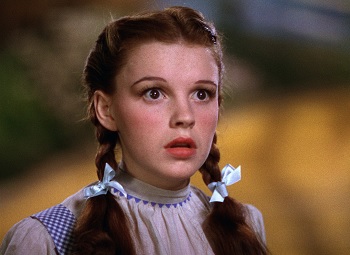
You'll understand why she has that shell-shocked look on her face real soon.
That's Judy Garland playing Dorothy in The Wizard Of Oz. She was 16 years old when she played the character, but she'd been working for MGM since she was 13. And 13, for those of you who haven't hit puberty yet, is a sucky age. Judy was both too old for kid roles and clearly too young for lady parts.
Luckily for her, one of the most inexplicably popular stars in the world at the time was about her age and about her size (she was 4'11"). Mickey Rooney was Justin Bieber for the Depression crowd, and Judy Garland was his ... Selena Gomez? His Lionel Richie's Daughter? Maybe his Tyga? Whoever Justin Bieber is dating by the time this article runs, Judy Garland was the onscreen version of that person in the 1930s. Together, Garland and Rooney made movies at a nonstop pace throughout their teen years. And when we say "nonstop pace," we mean that they'd finish one movie and start another hours later. The kids were expected to work 18-hour days, six days a week, all while looking so wholesome that you could eat cookies off their foreheads.
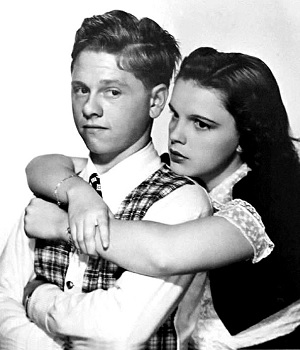
Delirium never looked so dapper.
The problem, as MGM soon figured out, was that children need pharmaceutical help to work those kinds of hours. It wasn't long before the kids were given amphetamines to keep them going during the day, and sleeping pills to calm them down at night. As an alcoholic, drug-addicted adult, Garland put it like this:
![They had us IMickey and Judy] working days and nights on end. They'd give us pills TO keep us on our feet long after we were exhausted. Then they'd t](https://s3.crackedcdn.com/phpimages/article/2/4/1/571241.jpg?v=1)
But hey, she lived a full three more decades before the barbiturates MGM got her started on killed her.
Stars Were Put On A Makeover Assembly Line

While plastic surgery has been a miracle for those suffering from various diseases, injuries, and, of course, the ravages of time, the procedure was used by Hollywood to hack their stars to fit the personas it wanted for them. One studio used hair dye and electrolysis to transform Latina nightclub singer Margarita Cansino into all-American white girl Rita Hayworth.

And you thought today's Hollywood whitewashing was bad.
One thing hasn't changed over the decades: All young lady stars were expected to stay skinny. While modern actresses can call on stylists, fitness gurus, internet tricks, and Gwyneth Paltrow's garbage version of wisdom to find weight loss tricks, old-timey stars simply obeyed their studios. For the best example, let's go back to Judy Garland. When her first movie came out, her studio told her she looked like a "fat little pig in pigtails." She was 14 years old.

They wanted her to follow Bulimia Road before even thinking about a yellow brick one.
For the next few years, MGM kept Garland on a calorie-restricted diet, and had plates of food taken away from her as she sat down to eat in the studio cafeteria. They sent internal memos about her weight gain and how her costumes were fitting. They gave her diet pills, and ordered the cafeteria staff to only let her eat chicken soup until she got skinny. According to the guy she married at age 18, the head of the studio encouraged her to smoke up to 80 cigarettes a day to suppress her appetite.

Here's her recipe for a salad she loved to smell at a distance while others ate happily.
When 1950s starlet Kim Novak showed up at the 2014 Oscars, the entire universe had a freakout about her surgically altered face. She took the criticisms in stride, since she was an old pro at getting bullied about her looks. When she first got to Hollywood, her studio changed her name, gave her lavender highlights, and told her to speak with a breathier voice. When Novak overate one day after a visit to a farmer's market, one of her actress girlfriends suggested she remedy the mistake by drinking soap and water -- which she did, before getting a ride to the hospital.
Even silent movie stars were ordered to get on the skinny side of healthy before they were deemed worthy of being seen by audiences. Swedish actress Greta Garbo was told to lose 20 pounds before she appeared on-screen because "in America, we don't like fat women." Garbo starved herself by eating nothing but spinach for three weeks, and lived on calorie-restrictive diets for the rest of her life, even moving her weirdo nutritionist into her home with her. Of course, the studio retired her at the old age of 36. Those cheekbones, though!

Starvation jaundice looks like a healthy glow in black and white.
Parents, Fixers, And Spies Controlled Actors' Lives
It wasn't enough for Hollywood moguls to plan their actors' looks, mannerisms, personas, and careers. Their asphyxiating hands of control would extend into every aspect of their stars' lives. When the very blonde, very white Kim Novak fell head over heels for black singer Sammy Davis Jr., producer Harry Cohn had the mob put out a hit on Davis, threatening to have him killed if the affair with Novak continued. Davis backed down.

Which is surprising, given the gangsters he used to run with back in the day.
Mickey Rooney had garnered a little bit of a reputation as a playboy. When Rooney had finally decided to settle down and marry fellow MGM celebrity Ava Gardner, producer Louis B. Mayer told Rooney that as long as he worked for him, Rooney's life was in Mayer's hands, straight-up forbidding the union. Eventually, Rooney won out and married Gardner.
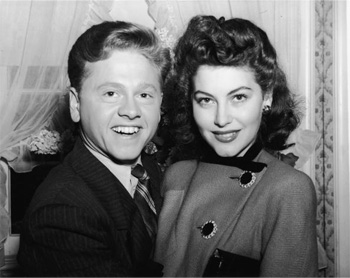
Presumably after his boss said, "Dayammmn, son. How!?"
To keep stars from making too many of their own decisions, studios would appoint caretakers to watch over them, as if they were helpless children. Garland and Rooney were given assistants who would advise, mandate, and report back to the studio on every aspect of their behavior. Rooney was fully aware of his studio-appointed "friend's" real purpose. Garland, sadly, was clueless. When she discovered her longtime confidante was a secret nanny-spy, she was devastated. Seriously, Judy Garland couldn't catch a break.

This look wasn't a onetime thing.
Before child stars aged enough to receive their contractually-obligated best friends, their parents were given the task of ensuring their little ones would toe the Tinseltown line. Garland, Elizabeth Taylor, and Shirley Temple were under the management of their mothers, who would agree to the studios' rigid guidelines and work schedules for their own salaries. Which is bad enough on its own, without taking into account all the rampant sexual abuse these ladies were subjected to at the hands of producers. Like the time Temple was flashed by producer Arthur Freed when she was 12. Temple laughed at his privates, and he threw her out of his office.

"Yeah, that looks like the stick of the Good Ship Lollipop. Nice try, asshole."
Garland (again!) said she was molested by the head of the studio himself, who would grope her breasts while "complimenting" her singing talents.
The obsessive need for control got so out of hand that execs eventually began bugging their actors' offices and homes, ensuring knowledge of their every move. Columbia producer Harry Cohn bugged both Rita Hayworth and her ex-husband, Orson Welles. Welles caught on to the buggery, and was sure to vocally greet Cohn upon arriving at the office every day.

Just because he cared a lot doesn't mean he gave a shit.
Despite the studios' meticulous monitoring of their commodities, actors weren't always kept fully under control. When a celebrity did screw up, "fixers" would be deployed to go clean up the mess. If Clark Gable caused a car accident, fixers would find a different actor to take the fall for it. If Jean Harlow's husband was murdered, fixers would make it look like suicide. And if an actress was gay and fell in love with another woman, fixers would leak to the press about her budding romance with the manliest of men. Old-timey LGBTQ celebrities who were forced into publicity-stunt hetero relationships were the lucky ones. Others were straight-up forced into studio-arranged marriages to hide their sexual preferences. It should probably come as no surprise to you that two of Judy Garland's six husbands were actually gay men trying to fake it as heterosexuals in Hollywood.

Pictured: Dorothy and her friend.
Hey, speaking of Judy Garland ...
Forced Abortions

By the time Garland was 18, she was ready to get a little freedom from her studio bosses. So she did what any reasonable 18-year-old kid would do: She married a 31-year-old songwriter who immediately got her pregnant. Of course, the studio deemed Judy's innocent ingenue days not over, and refused to let a little thing like the miracle of life change that. Claiming that Garland's sweet and innocent demeanor would be tarnished by the state of motherhood, the studio -- and Garland's own mother -- arranged for her to have an abortion.

Please support our Kickstarter to build a time machine to go back and give Garland the "It's not your fault" speech from Good Will Hunting.
Jean Harlow, or "the Blonde Bombshell," wasn't allowed to marry because a wife "couldn't be a bombshell." So she screwed around with her boyfriend without a marriage license. Before you knew it, it was time to schedule an "appendectomy."
Tallulah Bankhead was said to have had more abortions than most women had perms. When Joan Crawford thought she was pregnant with Clark Gable's baby, her studio fixer arranged for a secret abortion. Crawford told her ex-husband she had slipped on a cruise ship and lost their baby, rather than spill the beans about her affair with Gable.

Also, it's possible he could've been jealous that he didn't get to have an affair with Clark Gable.
Minority Actors Had It Worst of All

The desired end result of selling your soul to the Silver Screen Devil is to be showered with glitz, glam, and a whole bunch of sparkly gold award statues. Otherwise, what's the point? Artistic expression? What a load of bullhockey.
If you happened to be white and successful, bully for you! You were then able to participate in fancy Hollywood gatherings and awards shows, lavished with attention and accolades. If you happened to be black, well, we're pretty sure you can guess how that went.
When African-American actress Lena Horne arrived in Hollywood in the 1940s, she came with a plan. Her dad made her studio promise that his well-connected, affluent daughter would never play a maid on film. She got glamour shots and publicity like the other women in her studio ... and she didn't get any parts. When they finally cast Horne in an all-black movie called Cabin In The Sky, her big scene was cut for audiences in the South. Oh ... we should mention that her biggest scene consisted of her singing a song naked in a bathtub.

Kill the part where she's human, keep the part where she's a sex object. Sounds perfectly Hollywood to us!
She had to go to Europe to secretly marry her white husband, and gave up on Hollywood altogether by the 1950s. And Horne, by the way, had the best shot of getting fair treatment from the studios. Gone With The Wind's African-American actors and actresses never stood a chance.
When the toilets on the Gone With The Wind set were segregated, an 18-year-old extra named Lennie Bluett took Clark Gable on a special tour of the studio, opening his eyes to the hardships of being an African-American actor in the 1930s. Gable was so upset about what he saw that he called the director right away and threatened to quit the movie if the "white" and "colored" signs weren't taken down immediately.

Frankly, and thankfully, he did give a damn.
African-American actress Hattie McDaniel stole the show in Gone With The Wind, to the point where critics and audiences couldn't manufacture a reason not to nominate her for an Academy Award. McDaniel herself marched the glowing reviews of her portrayal of Mammy to her director's desk so he would make sure she was submitted for consideration. Not only was she nominated, she won. And she won against her white costars. But when it came time for the ceremony, McDaniel couldn't sit with them -- she had to sit at a separate table, and was only allowed into the building because her agent had called in some favors before the ceremony.
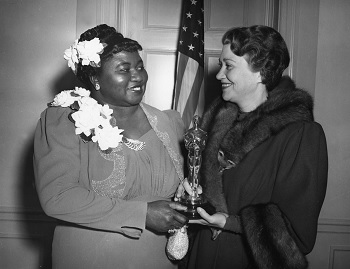
"Congrats on your hard work, I guess, but you did clean all the toilets, right?"
After getting an Oscar, Hattie was asked to dress up as her Mammy character and tour the country promoting the movie. Then she was cast in another 70 maid roles before dying of breast cancer in the early 1950s.
Good news for Judy Garland fans, though! Racial discrimination was the one area studios couldn't figure out how to screw her on.
Also check out 7 Popular Old-Timey 'Hobbies' That Will Give You Nightmares and 5 Horrifying Realities Of Daily Life Edited Out Of History.
Subscribe to our YouTube channel, and check out Why The Sandlot Is Secretly About American Racism, and other videos you won't see on the site!
Also, follow us on Facebook, and let's be best friends forever.
Every year we're inundated with movies that are based on true stories. We're about to get a Deepwater Horizon movie where Mark Wahlberg will plug an oil spill with his muscles, and a Sully Sullenberger movie where Tom Hanks will land a plane on the Hudson with acting. But we think Hollywood could do better than this. That's why Jack O'Brien, the Cracked staff and comedians Lindsay Adams, Sunah Bilsted, Eli Olsberg, and Steven Wilber will pitch their ideas of incredible true stories that should be made into movies. Get your tickets for this LIVE podcast here!
